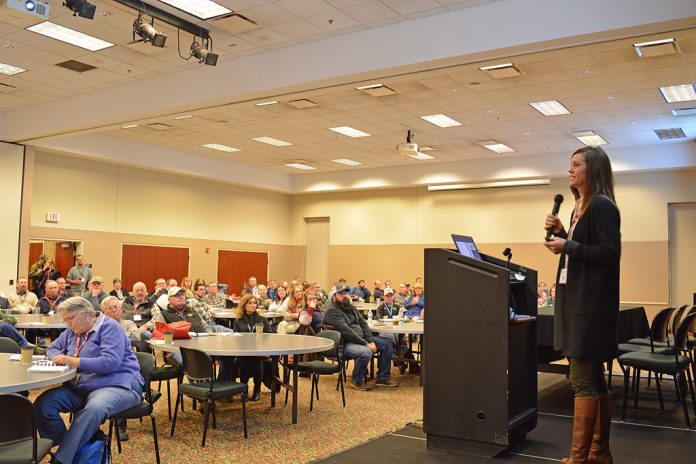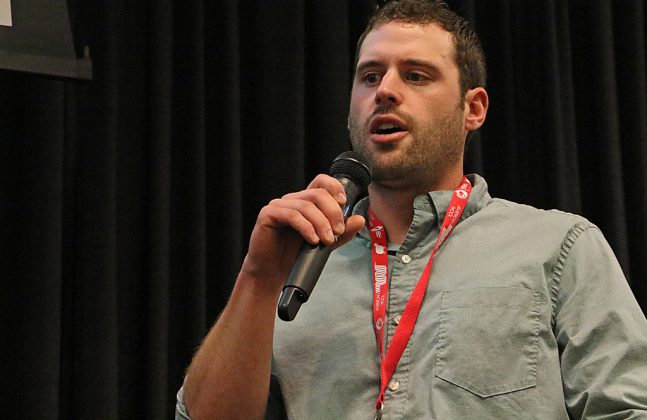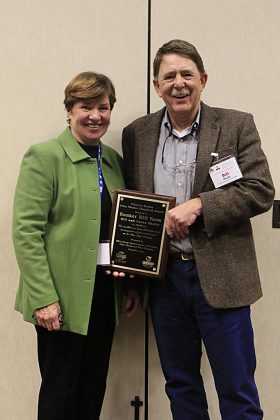
WOOSTER, Ohio — There aren’t many people Sandi Brock, Canadian sheep farmer and rising social media personality, would leave the barn during lambing for — except a group of other sheep farmers.
“I’m a sheep farmer, and I’m proud to be in this room with others,” Brock told those gathered for the 2019 Ohio Buckeye Shepherds’ Symposium, in Wooster, Ohio. The event, Dec. 13-14, which celebrated the 70th anniversary of the Ohio Sheep Improvement Association, drew more than 115 the first day and more than 200 the second, organizers estimated. Speakers covered best practices for management and nutrition and current issues affecting sheep farmers, such as water quality and the current lending environment.
Her story
Over the course of two days, Brock shared her story. The daughter of a dairy farmer, she spent more than a decade working in the broiler breeder chicken business with her father-in-law and brother-in-law. Now, she and her husband, Mark, run a grain and sheep farm, in Staffa, Ontario. Mark runs the grain operation, which is around 1,800 acres. Sandi runs the sheep business, which is solely indoors, on an accelerated system. She schedules lambing times multiple times during the year, with one currently underway.
“For those who do follow me on social media, I share very, very openly and candidly,” she said. It’s her goal: she wants to share everything. If it helps someone, all the better.
“You gotta be honest. We’ve all had the train wrecks, and I don’t think enough of us talk about it,” she said. “I love talking about the train wrecks.”
Hard beginning
She started in sheep in 2012, with a renovated pig barn. “I literally thought it was going to be easy, and it’s … the hardest thing I’ve ever done,” she said.
It was in part because of the early decisions they made. How did she start? “I Googled it.” They researched everything. She visited other sheep farms. Things seemed promising, on paper.
She bought sheep from a dealer, who likely had purchased the sheep from various stockyards. In 2013, the lamb market in Ontario crashed. She had sheep of unknown origins, and no market to sell the lambs to. Things were dicey.
“So, what did we do? We expanded.” Laughter rippled through the room. Within a year or two, they had scaled up to 500 ewes — more than doubling the flock size. And they built a new barn. She does not recommend doing all of that, together.
Reboot
She and Mark talked. They decided to retool how they did things. They had the equipment and the knowledge. They needed to feed their own sheep with what they produced, to get costs down. And do it efficiently. The idea being that they could feed 500 sheep in the same time it took to feed 50 or 100. They started planting hay and harvested corn silage for feed. They improved the systems for feeding the sheep.
Having all of her sheep housed is something Brock loves. “I do like having everything under one roof,” she said. “I’ve literally been born and raised in a barn, so to have all my sheep under one roof — one beautiful, glorious roof — for me, it’s peaceful and calming, and I can do all of my work quickly and efficiently.”
While she is still learning, Brock said her dairy roots have inspired her take on nutrition. A well-fed cow gives a lot of milk. So too, a well-fed ewe should provide a good lamb crop. “I’m going to treat these sheep like a dairy cow, but I expect them to perform like a dairy cow,” she said.
As her notoriety has grown on her YouTube channel, especially, Brock said it has turned into a creative outlet, and now, it even provides a bit of income. “It’s kind of nice to have a little bit of a side hustle without leaving the farm,” she said.
Cameron Lauwers
A Michigan farmer, Cameron Lauwers, also spoke both days about his operation. A first-generation sheep farmer, he runs about 600 ewes in a housed, accelerated system. Nutrition is key, he said. As are efficient systems and an eye for reducing stress on animals.
Master shepherds
Bill and Susan Shultz, of Bunker Hill Farm, in Logan County, won the 2019 Charles Boyle Master Shepherd Award. In a way, it was a full-circle moment. The Shultzes have a long history of serving in leadership with the Ohio and national sheep industry associations.
Bill Shultz’s father, Farrell, was the first president of the Ohio association in 1949. Bill was elected in 1979, and Susan also served in 2009. Currently, Susan serves as vice president of the American Sheep Industry Association.
With roots in Shropshire breeding, and a bit of work with Rambouillets, the Shultzes now raise purebred Suffolk breeding stock. They work extensively with National Sheep Improvement Program data within their flock and have consulted on ongoing efforts in Utah to assess the value of data-backed range rams. They are also pushing forward with plans for new genetic testing of their flock.
Distinguished service
Jeff McCutcheon, of Licking County, was awarded the 2019 Distinguished Service Award. McCutcheon is the southeast regional Ohio State Extension director.
Emma Preston
Preston, of Fairfield County, is the 2019-2020 Ohio Lamb and Wool Ambassador.
Dylan Goodman
Winner of the 2019 Ohio FFA Sheep Proficiency Award, Goodman is from Morrow County.
Rachel Berk
Berk, of Franklin County, was the 2019 Ohio 4-H Sheep Award winner.
Chelsea Graham
Graham, of Licking County, earned the 2019 Dr. Jack Judy Memorial Scholarship.
Sidney McAllister
McAllister, of Darke County, earned the 2019 OSIA LEAD Scholarship.
Grimshaw scholarship
Winners of the 2019 Ralph H. Grimshaw Memorial Scholarship were: Ariana Spina, Champaign County; Jimmy Stickley, Champaign County; and Isaac Gehrt, Darke County.















Saw a video with you trimming hoofs without gloves on!!! My advice is to wear gloves to prevent blisters and nasty accidents. Also consider putting a base that give the trimmed ewes traction to get out of the rotating press.
Thank you nice to meet you
Does she still have chickens?